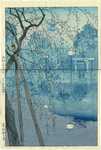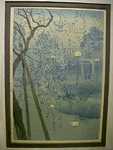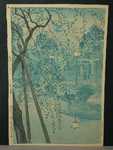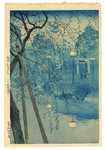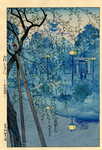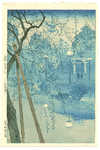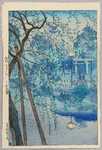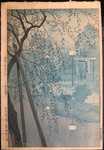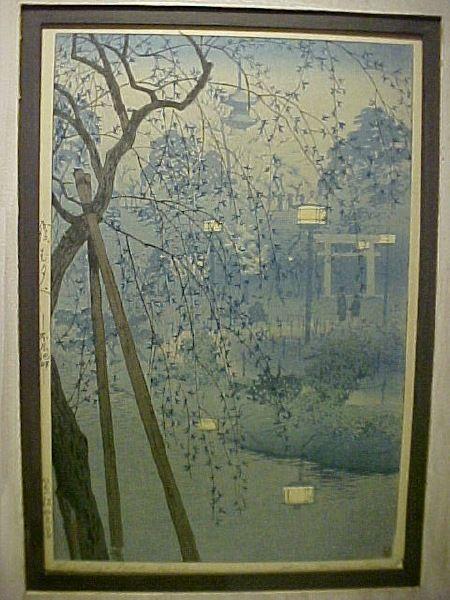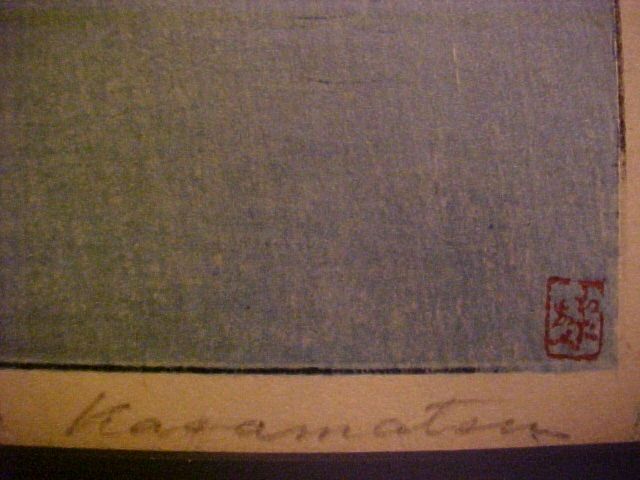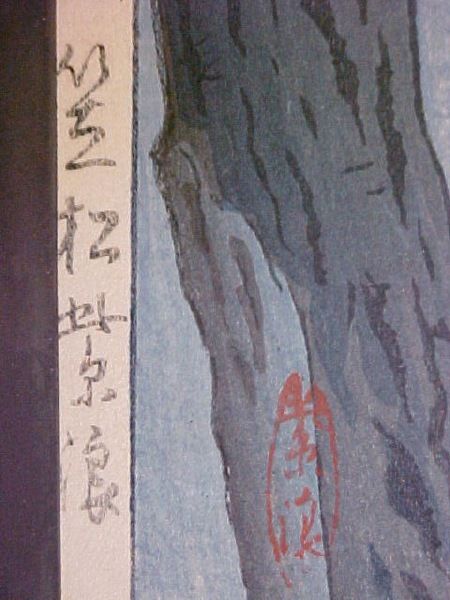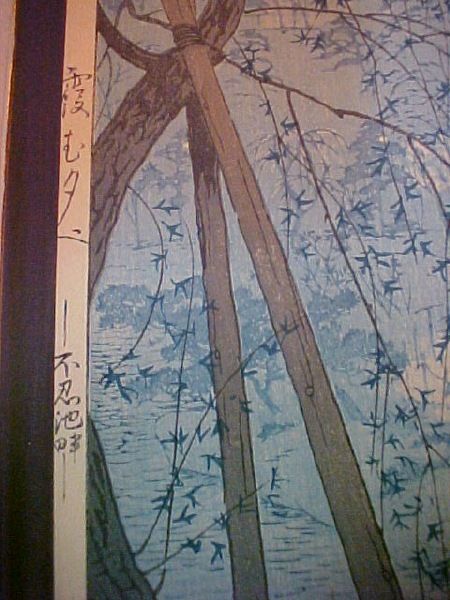| Notes (this edition)?: |
| The following information was taken from the original web listing of this artwork. Note that there may be some inaccuracies:
Misty Evening at Shinobazu Pond , Ueno
Shiro Kasamatsu 1898-1991
This print bares Watanabe H Seal in lower right corner.
Signed in pencil,`" Shinobauz Pond, Unoe" Shiro Kasamatsu.
This print has a Kento mark in right bottom of paper.
It was a " presentation"to
James A. McCarty, Capt. USMC. Legal Sec.,GHQ, SCAP ( Supreme Commander Allied Powers) in Japan 1947.
This and a collection of Hiroshige prints, also gifts, were shipped back
Dec. 13th, 1947.
All were purchased together from the Family Estate several years ago. This print was custom framed, glue tape along back edges of paper to hold in place. It will come off per 'preservationist'. From the frame shop phone, 5 digit, number that was on the back I would say it has been in the frame since early 1948. Condition is pristine.
There has been some controversy about Watanabe's use of his H 'artist proof'and 'gift seal'. In correspondence last year with a noted authority and author on Kasamatsu he informed me of a book published by Watanabe of his own works, many bore his H seal and stated he would never publish lesser quality works for his own publication.
As they are gifts, they were not printed in mass, thus bearing no date, as the date of receipt was often within days of it's often single printing.
The lower right corner block line in this print has been lifted so as to 'highlight'the seals importance'.
As to the limb in upper left center of the print being carried beyond the block line,(see picture), it has been suggested it was done by Kasamatsu himself to ' personalize' this gift as being from him and his publisher,
Watanabe.
|
|
| Artist Bio: |
ABOUT SHIRO KASAMATSU
Born in the Asakusa section of Tokyo to a middle class family, Shiro Kasamatsu started his art studies at a young age. In 1911 he became a student of Kaburagi Kiyokata, a master of the bijin-ga genre. Shiro studied Japanese style painting (Nihonga) but unlike his teacher, he concentrated on landscapes. Kiyokata chose his artist's name "Shiro", which used the character shi from one of Kiyokata's own pseudonyms and was conveniently an alternate spelling of Kasamatsu's given name.
Shiro's paintings were shown at several prestigious exhibitions including the government sponsored Bunten, where they caught the eye of Watanabe Shozaburo, a Tokyo publisher. In 1919, Watanabe approached Shiro about designing woodblock prints. No doubt Kiyokata facilitated this introduction as he had done for several other students, including Kawase Hasui and Ito Shinsui. Shiro's first print, A Windy Day in Early Summer, was published in that same year. He designed several landscape prints over the next few years, but the blocks for these were lost in the 1923 Kanto earthquake and consequently they are quite rare.
Shiro resumed his work with Watanabe in the 1930's. His designs were mainly of landscapes, but also included bijin-ga, interiors, and Noh masks (one of his particular interests). Western collectors were especially attracted to his romantic landscapes depicting traditional Japanese life and landmarks. Shinobazu Pond, published in 1932, was so popular that it was continually reprinted throughout the 1930's and 1940's. It was published in several different color combinations, including an aizuri-e (blue) version. In this print and many others, Shiro used foreground elements like branches to draw in the viewer and give the image depth. This was a design technique first originated by the ukiyo-e artist Hiroshige.
In 1939, Shiro designed the series Eight Views of Tokyo, but only four prints were completed. His relationship with Watanabe was nearing a close, probably because Watanabe did not give him the creative control that he desired. Shiro was intrigued by the independence of sosaku hanga printmakers who carved and printed their own designs. After World War II, he stopped working with Watanabe. However, it would be nearly a decade before Shiro began producing his own prints. In the meantime, he established a short collaboration with Unsodo, a publisher in Kyoto, designing landscape and animal prints. Many of the prints published by Unsodo are quite striking and compare favorably with the Watanabe-published prints.
By the late 1950's, Shiro was ready to break out on his own. He began carving and printing his own designs in limited, numbered editions. He signed these prints himself in English. Some of his Watanabe-published prints also bear English signatures; however, these signatures were applied by Watanabe's employees, not by the artist himself.
Although Shiro's self-made prints lack the refined carving of his shin hanga designs, they have a simplicity and expressiveness that is very appealing. The upward carving strokes and angular lines of Five Story Pagoda at Dusk make it one of Shiro's most dynamic prints. The building seems ready to explode off the paper. In contrast, the grid-like designs of Passage and Windows of Tearoom help to convey a sense of tranquility. Shiro continued to create prints for several decades, but never promoted them through exhibitions or gallery affiliations. As a result, his self-carved prints were more a labor of love than a commercial success.
|
|



